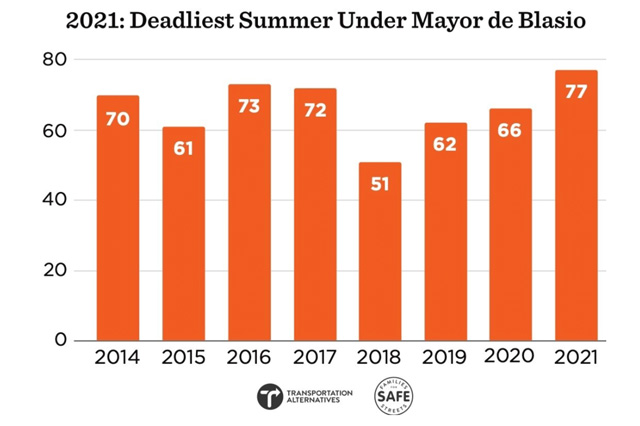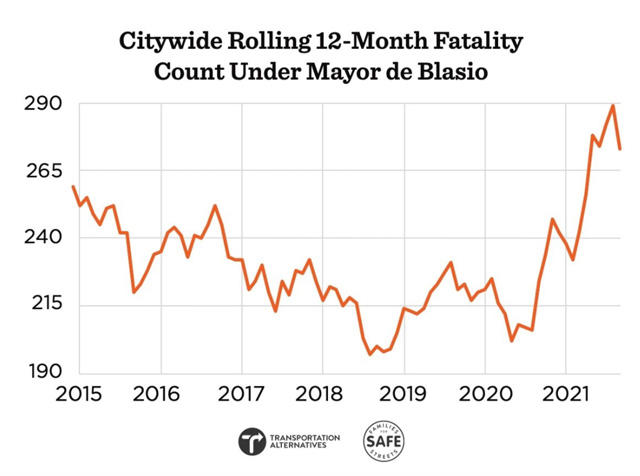NYC Boroughs Rank Low on Pedestrian Safety

By Eudy Castro
Staten Island and the Bronx are the top two most dangerous communities in the U.S. for pedestrians, according to an analysis by Insurify, a car insurance comparison site. In Staten Island, 53.6 per 10,000 drivers received a violation for failing to yield to a pedestrian, 45.9 per 10,000 drivers in the Bronx. Brooklyn came in fourth place and Manhattan in sixth in the ranking with 28.4 drivers per 10,000 drivers. In comparison, the 20th most dangerous, Dayton, Ohio, came in at 17.9 per 10,000 drivers. In the city overall, at least 266 pedestrians, cyclists and motorists have been killed in 2021, the highest number since 2013 when 299 people died.
Drivers that come from highways in the Bronx often fail to reduce their speed as they exit onto the borough roads, says Shawn Garcia, the Bronx organizer of Transportation Alternatives, a non-profit advocate for biking, walking, and public transit safety in the city. Changes to the speed limit from 25 mph to 20 or possibly even 15 mph would increase pedestrian safety says Garcia. It is a small change, but it would make the streets safer for both the pedestrians and drivers.
Another cause of car fatalities is infrastructure, says Garcia. New York City’s infrastructure in general is not built to withstand high traffic, especially in areas like downtown Manhattan. Double and triple parked cars in the street and in school zones further complicate the situation.

There were 62 deaths and injuries of pedestrians in the summer of 2019. However, the COVID-19 pandemic has variously changed and exacerbated several trends. In summer 2020, there were 66 deaths and injuries. The lockdown during the early stages kept many people inside, but issues arose as people slowly emerged. “The pandemic has made the safety of pedestrians worse because traffic has increased due to people not wanting to use public transportation,” said Garcia.
Statistics from TA show that this past summer has been the worst summer ever with an increase in fatal crashes. There were 77 total fatalities of pedestrians, cyclists, motorists, passengers and delivery workers. The borough seeing the largest number of fatalities was Brooklyn. “In summer 2021, crashes killed 23 individuals in Brooklyn, making it the deadliest summer in Brooklyn of any year under Mayor de Blasio,” says Transportation Alternatives. “The total fatalities through the end of September is 63, a full 40 percent higher than the de Blasio-era average by this point in the year.”
“We are a pro-life organization,” said Garcia. “We want to make sure that the streets are a safe environment for pedestrians who walk and bike.” TA gets residents involved through rallies, petitions, advocacy and board meetings. “Because of people getting involved with our organization, we were able to enforce many changes,” savs Garcia. “Speed lane cameras were added because of TA’s advocacy and this has resulted in speed limit violations.”

Families for Street Safety is part of TA. “We have worked closely with victims of car fatalities and much of this organization is led by those victims,” said Garcia. These victims are looking to unite other victims, not leaving them to deal with the fatalities by themselves. They want more victims to stand and fight for improved pedestrian safety. Transportation Alternatives and Families for Street Safety encourage people to get involved with the push for better street and pedestrian safety. The louder the voices, the more enforcements will be added in order to improve safety, say advocates. More information can be found on the organization websites at https://www.familiesforsafestreets.org/get-involved and https://www.transalt.org/take-action
Vision Zero is a policy the de Blasio administration introduced in 2014 to devise strategies to eliminate all traffic fatalities and severe injuries. In response to these trends, Mayor de Blasio and Vision Zero have implemented more bike lanes in the streets. One of the biggest goals of the TA was to make the streets better for both walking pedestrians and cyclists. Elizabeth Kim, Jessica Gould and Stephen Nessen evaluated the mayor’s performance on transportation, in which they noted, “When de Blasio started his first term, there were 300 miles of bike lanes. As of 2020 there are 1,375 painted bike lanes, and 546 miles of protected bike lanes, with more being installed before the end of this year. The TA believes that the addition of protected bike lanes helps cyclists stay off the streets, which helps prevent injuries and fatalities.”
Saved under Featured Slide, News
